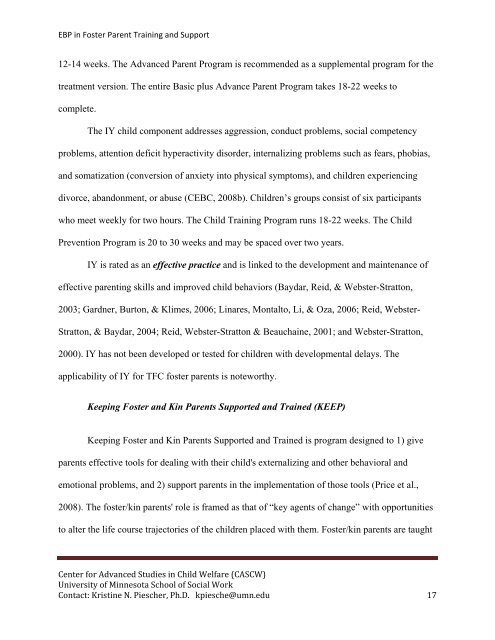Evidence-Based Practice in Foster Parent Training and Support ...
Evidence-Based Practice in Foster Parent Training and Support ...
Evidence-Based Practice in Foster Parent Training and Support ...
You also want an ePaper? Increase the reach of your titles
YUMPU automatically turns print PDFs into web optimized ePapers that Google loves.
EBP <strong>in</strong> <strong>Foster</strong> <strong>Parent</strong> Tra<strong>in</strong><strong>in</strong>g <strong>and</strong> <strong>Support</strong>12-14 weeks. The Advanced <strong>Parent</strong> Program is recommended as a supplemental program for thetreatment version. The entire Basic plus Advance <strong>Parent</strong> Program takes 18-22 weeks tocomplete.The IY child component addresses aggression, conduct problems, social competencyproblems, attention deficit hyperactivity disorder, <strong>in</strong>ternaliz<strong>in</strong>g problems such as fears, phobias,<strong>and</strong> somatization (conversion of anxiety <strong>in</strong>to physical symptoms), <strong>and</strong> children experienc<strong>in</strong>gdivorce, ab<strong>and</strong>onment, or abuse (CEBC, 2008b). Children’s groups consist of six participantswho meet weekly for two hours. The Child Tra<strong>in</strong><strong>in</strong>g Program runs 18-22 weeks. The ChildPrevention Program is 20 to 30 weeks <strong>and</strong> may be spaced over two years.IY is rated as an effective practice <strong>and</strong> is l<strong>in</strong>ked to the development <strong>and</strong> ma<strong>in</strong>tenance ofeffective parent<strong>in</strong>g skills <strong>and</strong> improved child behaviors (Baydar, Reid, & Webster-Stratton,2003; Gardner, Burton, & Klimes, 2006; L<strong>in</strong>ares, Montalto, Li, & Oza, 2006; Reid, Webster-Stratton, & Baydar, 2004; Reid, Webster-Stratton & Beaucha<strong>in</strong>e, 2001; <strong>and</strong> Webster-Stratton,2000). IY has not been developed or tested for children with developmental delays. Theapplicability of IY for TFC foster parents is noteworthy.Keep<strong>in</strong>g <strong>Foster</strong> <strong>and</strong> K<strong>in</strong> <strong>Parent</strong>s <strong>Support</strong>ed <strong>and</strong> Tra<strong>in</strong>ed (KEEP)Keep<strong>in</strong>g <strong>Foster</strong> <strong>and</strong> K<strong>in</strong> <strong>Parent</strong>s <strong>Support</strong>ed <strong>and</strong> Tra<strong>in</strong>ed is program designed to 1) giveparents effective tools for deal<strong>in</strong>g with their child's externaliz<strong>in</strong>g <strong>and</strong> other behavioral <strong>and</strong>emotional problems, <strong>and</strong> 2) support parents <strong>in</strong> the implementation of those tools (Price et al.,2008). The foster/k<strong>in</strong> parents' role is framed as that of “key agents of change” with opportunitiesto alter the life course trajectories of the children placed with them. <strong>Foster</strong>/k<strong>in</strong> parents are taughtCenter for Advanced Studies <strong>in</strong> Child Welfare (CASCW)University of M<strong>in</strong>nesota School of Social WorkContact: Krist<strong>in</strong>e N. Piescher, Ph.D. kpiesche@umn.edu 17
















